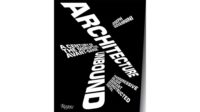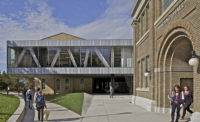What do architects Louis Kahn, Paul Rudolph, and Eero Saarinen have in common? Yes, they were all masters of 20th-century architecture. In addition, they were all affiliated with—and designed buildings for—Yale University. With Untimely Moderns: How Twentieth-Century Architecture Reimagined the Past, author Eeva-Liisa Pelkonen further enriches our understanding of these figures by asserting that, beyond an institutional affiliation, what binds them and a handful of other key architects, artists, and historians is a “shared penchant for conflating the past, present, and future in their work and words.” Rather than view modernity as a rejection of the past, they adopted an “untimely” approach that jettisoned chronology as they investigated art and architecture’s relationship to history and time. Pelkonen dubs this group the “untimely moderns” and proposes that, between the 1920s and 1970s, Yale offered a uniquely attuned environment for their multidisciplinary explorations.
In Untimely Moderns, Pelkonen—assistant dean and professor at the Yale School of Architecture—presents her argument in three sections, each broken into chapters. Part one, titled “Constancy and Change,” introduces the intellectual and physical conditions that fostered the untimely moderns’ investigations. Pelkonen begins with Everett Victor Meeks, chair of the Department of Architecture and dean of the Yale School of Fine Arts from 1922 through 1947, who established a “dual curriculum” that balanced technical instruction (studio) and liberal arts–based education (history and criticism). With this pedagogical platform, Meeks sought to instill a sense of continuity between past and present in the midst of a rapidly progressing world. Yale’s campus was changing as well during these years; the “Modern Gothic” idiom adopted by architect James Gamble Rogers for Yale’s expansive building campaign likewise grappled with—and prompted heated debates about—how architecture should relate to bygone eras.
Building on the foundation afforded by Meeks and Rogers, the second part, “Time and History,” explores the next stage in the untimely moderns’ evolution. Pelkonen examines French art historian Henri Focillon, invited by Meeks to Yale in 1933, who embraced a “unique historical method of unmooring works of art from fixed spatial and temporal coordinates.” Focillon taught at the university for the next decade, helping to establish its art history department and serving as intellectual mentor to successive generations of historians, including George Kubler and Vincent Scully, who would become eminent Yale fixtures. Meanwhile, German artists Josef and Anni Albers brought their Bauhaus-derived teaching philosophy to the School of Fine Arts when Meeks’s successor tapped Josef to modernize the arts curriculum. Rather than offer conventional instruction in art history and appreciation, Albers instituted a design studio sequence to cultivate awareness of art’s “trans-historical essence” and “timeless principles,” which were to guide students’ future explorations.
The final section, “Past and Future,” contains four chapters that investigate architectural works in relation to time-based concepts, linking architects and historians (or, in one case, a philosopher): Kahn and Paul Weiss; Saarinen and Kubler; Rudolph and Sibyl Moholy-Nagy. The last chapter, “Vincent Scully: The Historian’s Revenge,” seems an anomaly in that, while the book’s prolegomenon forecasts Scully’s pairing with architect Robert Venturi, the latter appears very little in the text and not at all in the chapter title (unlike the previously mentioned architects, who receive top billing). This lack of attention is curious—Venturi was, in many senses, an embodiment of the “historian’s revenge.”
It may be ironic that, to chart the nonlinearity of the untimely moderns’ approach, Pelkonen relies on a sequential (albeit overlapping) framework. Yet this is of necessity; without a temporal touchstone, it’s difficult to craft a compelling narrative, let alone one with so many diverse characters and lines of thought. Pelkonen weaves them together admirably, underscoring the immense variety that exists under the deceptively compact term “modern” as well as the multifaceted approaches that comprise architectural modernism as it evolved along with Yale’s campus and curriculum. This book joins the growing body of 21st-century research that successfully unpacks accepted histories to offer fuller, more nuanced interpretations of specific times, places, and concepts. As Pelkonen demonstrates with Untimely Moderns, such reevaluation proves quite timely.





Post a comment to this article
Report Abusive Comment